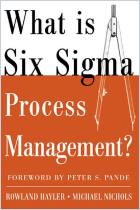Join getAbstract to access the summary!

Join getAbstract to access the summary!
Peter S. Pande, Robert P. Neuman and Roland R. Cavanagh
The Six Sigma Way
How GE, Motorola, and Other Top Companies Are Honing Their Performance
McGraw-Hill, 2000
What's inside?
Six Sigma: If it’s good enough for Jack Welch, it’s good enough for you.
Recommendation
Continual improvement is the key to survival in today’s business climate, and as companies like GE and Motorola have proven, Six Sigma is a useful tool for ingraining the quest for perfection in an organization. After reading The Six Sigma Way, you’ll probably be ready to jump out of your chair and immediately follow in these companies’ footsteps by launching a Six Sigma initiative of your own. The authors, three consultants who teach firms to implement Six Sigma efforts, convincingly extol the money-saving and efficiency-enhancing virtues of the holistic approach. This book offers a lot of jargon and complex concepts, but the material is presented in easily understood charts and lists, and there are plenty of concrete examples. getabstract.com recommends The Six Sigma Way to managers who have heard wondrous tales of Six Sigma, but would like a more down-to-earth explanation of how it can be used and the benefits it offers.
Summary
About the Authors
Peter S. Pande is president of Pivotal Resources, a consulting firm that has helped companies such as Citicorp and Chevron implement Six Sigma systems. Robert P. Neuman is a consultant and speaker in the area of Six Sigma methods. Roland R. Cavanagh is a professional engineer who has worked with companies such as America West Airlines, Commonwealth Edison and Tencor Instruments. All three authors also have done consulting work with GE and all live in California.


















Comment on this summary